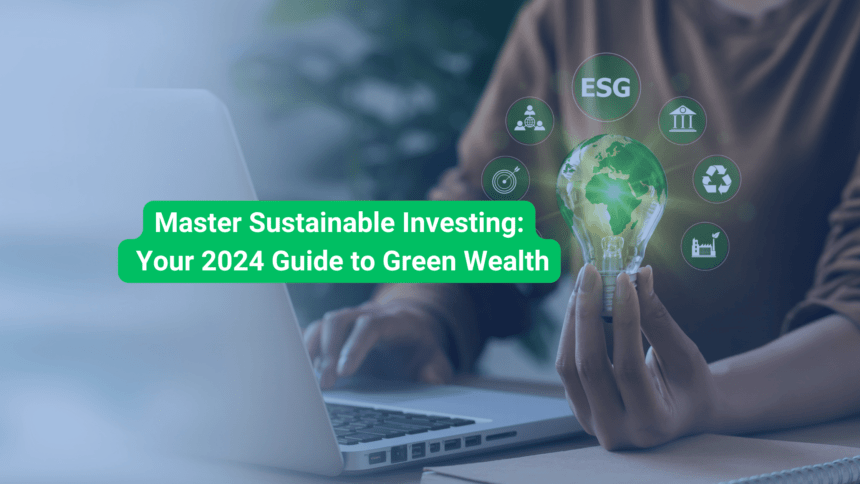Introduction to Sustainable Investing
Definition and Importance
Sustainable investing, often termed as ESG (Environmental, Social, and Governance) investing, integrates financial returns with social good. It has burgeoned into a pivotal investment approach, aligning profit motives with environmental stewardship, social responsibility, and robust governance. In 2024, this investment paradigm has transcended niche status, reflecting a global shift towards conscientious capitalism.
Historical Context and Evolution
The roots of sustainable investing trace back to the ethical investment movements of the 1960s, where social issues began influencing financial decisions. Over decades, it evolved from exclusionary practices—like avoiding “sin stocks” in tobacco and firearms—to comprehensive ESG criteria. The 21st century has witnessed exponential growth, driven by heightened environmental awareness and social activism.
Current Trends and Future Outlook
Sustainable investing in 2024, is not merely a trend but a fundamental shift. Investors are increasingly prioritizing ESG metrics, recognizing that companies excelling in these areas often outperform their peers. The future promises further integration of sustainability into mainstream finance, with innovations in technology and regulatory frameworks propelling this growth.
Understanding ESG Criteria
Environmental Factors
Environmental criteria examine how a company performs as a steward of nature. This includes energy use, waste management, pollution control, natural resource conservation, and treatment of animals. These factors influence regulatory compliance, operational efficiency, and brand reputation.
Social Considerations
Social criteria scrutinize how a company manages relationships with employees, suppliers, customers, and communities. It covers aspects like labor practices, product safety, and community engagement. Companies with robust social practices often enjoy enhanced employee satisfaction and customer loyalty.
Governance Aspects
Governance involves the framework of rules and practices ensuring accountability, fairness, and transparency in a company’s relationship with stakeholders. This includes board diversity, executive pay, audits, and shareholder rights. Strong governance reduces risks of malfeasance and enhances corporate reputation.
The Rise of Green Bonds
What Are Green Bonds?
Green bonds are debt securities issued to fund projects with positive environmental impacts. These projects range from renewable energy installations to pollution reduction initiatives. They provide a mechanism for investors to support sustainability while earning returns.
Benefits and Challenges
Green bonds offer dual benefits: financial returns and environmental stewardship. They attract a broad investor base, including those prioritizing sustainability. However, challenges include verifying the environmental benefits and standardizing reporting metrics to prevent greenwashing.
Case Studies of Successful Green Bond Projects
Successful green bond projects abound. For instance, the World Bank’s green bond initiatives have funded renewable energy projects across developing nations, significantly reducing carbon footprints. Another example is Apple’s green bond issuance, financing projects like energy-efficient buildings and recycled material usage.
Impact Investing Explained
Defining Impact Investing
Impact investing seeks to generate positive, measurable social and environmental impacts alongside financial returns. It emphasizes direct, tangible benefits, often targeting issues like poverty alleviation, education, and healthcare improvements.
Measuring Impact
Measuring impact requires rigorous standards and methodologies. Metrics might include quantifiable outcomes like reduced carbon emissions or increased access to clean water. Organizations like the Global Impact Investing Network (GIIN) provide frameworks for assessing and reporting impact.
Notable Impact Investment Funds
Prominent impact investment funds include the Acumen Fund, which invests in scalable businesses addressing poverty, and the RSF Social Finance, focusing on sustainable food and agriculture. These funds demonstrate that financial success can coexist with profound societal benefits.
Socially Responsible Investing (SRI)
Principles of SRI
Socially Responsible Investing (SRI) combines financial goals with ethical considerations. Principles include avoiding investments in companies with negative social impacts and supporting those promoting social good. This often entails screening potential investments based on ESG criteria.
SRI Strategies and Approaches
SRI strategies vary widely. Negative screening excludes harmful industries, while positive screening actively seeks companies excelling in ESG. Another approach is shareholder advocacy, where investors use their influence to drive corporate change.
Performance of SRI Portfolios
Contrary to skepticism, SRI portfolios often perform competitively. Numerous studies indicate that integrating ESG factors can reduce risks and enhance returns. For instance, companies with strong environmental practices tend to be more resilient against regulatory changes and resource scarcity.
Ethical Investing Practices
Ethical Screening Processes
Ethical screening involves evaluating companies against a set of ethical criteria before investment. This might include assessing labor practices, environmental policies, and governance structures. The goal is to align investments with personal or institutional values.
Avoidance vs. Engagement Strategies
Ethical investing can follow avoidance or engagement strategies. Avoidance shuns companies failing ethical standards, while engagement involves active dialogue to improve a company’s practices. Both approaches aim to foster ethical business conduct and long-term sustainability.
Long-term Benefits of Ethical Investing
Ethical investing isn’t just morally gratifying; it offers long-term financial benefits. Companies with ethical practices often enjoy stronger reputations, reduced legal risks, and enhanced operational efficiencies, translating to better financial performance.
The Role of Technology in Sustainable Investing
AI and Big Data in ESG Analysis
Artificial Intelligence (AI) and Big Data are revolutionizing ESG analysis. AI algorithms can process vast datasets to uncover ESG trends and risks, providing deeper insights and predictive analytics. This technology enables more informed and strategic investment decisions.
Blockchain for Transparency
Blockchain technology enhances transparency for sustainable investing in 2024. It ensures immutable and verifiable records of ESG compliance, mitigating risks of greenwashing. Blockchain’s decentralized nature fosters trust and accountability in ESG reporting.
Fintech Innovations
Fintech innovations are making sustainable investing in 2024 more accessible. Platforms offering robo-advisors and digital tools simplify ESG investment processes, catering to a broader audience. These technologies democratize investment opportunities, fostering inclusive growth.
Regulatory Landscape
Key Regulations and Policies
The regulatory landscape for sustainable investing in 2024 is evolving. Key regulations include the EU’s Sustainable Finance Disclosure Regulation (SFDR) and the UN’s Principles for Responsible Investment (PRI). These policies mandate transparency and accountability in ESG reporting.
Global Regulatory Differences
Regulatory frameworks vary globally. Europe leads with stringent ESG regulations, while other regions are catching up. Understanding these differences is crucial for global investors to navigate compliance and capitalize on regional opportunities.
Impact of Regulations on Investment Strategies
Regulations significantly influence investment strategies. Compliance with ESG mandates often necessitates portfolio adjustments, risk assessments, and enhanced reporting. Forward-thinking investors view regulations as catalysts for innovation and value creation.
Greenwashing: Identifying and Avoiding It
Definition and Risks
Greenwashing involves misleading claims about environmental benefits to attract investors. It poses risks to both investors and the broader market, undermining trust and distorting the true impact of investments.
Common Greenwashing Tactics
Common greenwashing tactics include vague claims, selective disclosure, and irrelevant comparisons. Investors must be vigilant, scrutinizing the authenticity and relevance of ESG claims to avoid deceptive practices.
Tools and Resources for Verification
Tools for verifying ESG claims include third-party certifications, ESG rating agencies, and blockchain records. Resources like the Sustainability Accounting Standards Board (SASB) and the Global Reporting Initiative (GRI) provide frameworks for robust ESG evaluation.
Sustainable Investment Funds and ETFs
Overview of Popular Funds
Popular sustainable investment funds and ETFs include the iShares MSCI KLD 400 Social ETF and the Vanguard FTSE Social Index Fund. These funds offer diversified exposure to companies excelling in ESG criteria.
Performance Metrics
Performance metrics for sustainable funds encompass both financial returns and ESG impacts. Investors assess these metrics to gauge the dual benefits of sustainability and profitability, ensuring alignment with their goals.
How to Choose the Right Fund
Choosing the right sustainable fund involves evaluating ESG criteria, financial performance, and alignment with personal values. Investors should consider factors like fund management, expense ratios, and impact goals.
Risk Management in Sustainable Investing
Types of Risks
Sustainable investing in 2024 involves various risks, including market, regulatory, and reputational risks. Understanding these risks is crucial for developing robust investment strategies that balance sustainability with profitability.
Mitigation Strategies
Mitigation strategies include diversification, rigorous ESG analysis, and engagement with investee companies. Proactive risk management enhances resilience and ensures long-term success in sustainable investing.
Case Studies
Case studies like Patagonia’s sustainable business model and Tesla’s environmental innovations illustrate successful risk management in sustainable investing. These examples highlight the benefits of integrating ESG principles into core business strategies.
The Role of Institutional Investors
Influence and Responsibilities
Institutional investors wield significant influence in sustainable investing. Their responsibilities include advocating for ESG integration, driving corporate change, and fostering industry standards. Their large-scale investments can catalyze widespread adoption of sustainable practices.
Institutional Investment Strategies
Institutional strategies often involve active ownership, impact investing, and collaborative engagements. These approaches leverage institutional power to achieve substantial ESG impacts and financial returns.
Case Studies of Leading Institutions
Leading institutions like BlackRock and CalPERS exemplify effective sustainable investing strategies. Their commitment to ESG principles has set benchmarks for the industry, demonstrating the potential of institutional influence.
The Future of Sustainable Investing
Emerging Trends
Emerging trends in sustainable investing include circular economy practices, biodiversity investments, and climate-resilient infrastructure. These trends reflect the evolving landscape and expanding opportunities in sustainability.
Predictions for the Next Decade
Predictions for the next decade envision sustainable investing becoming mainstream, with advancements in technology and regulatory frameworks. Increasing investor awareness and demand will drive innovation and integration of ESG principles.
Opportunities and Challenges
Opportunities for sustainable investing in 2024 are vast, from renewable energy to social enterprises. However, challenges like greenwashing and regulatory disparities persist. Navigating these challenges requires vigilance and adaptability.
How to Start Your Sustainable Investing Journey
Setting Your Goals
Starting a sustainable investing journey begins with setting clear goals. These goals might include financial returns, environmental impacts, or social contributions. Defining objectives helps guide investment decisions and measure success.
Researching Opportunities
Researching opportunities involves exploring ESG funds, green bonds, and impact investments. Resources like ESG rating agencies and sustainable investment platforms provide valuable insights and options.
Building a Diversified Portfolio
Building a diversified portfolio is crucial for balancing risks and rewards. Diversification across asset classes, geographies, and ESG criteria ensures resilience and long-term growth in sustainable investing.
Conclusion
Recap of Key Points
Sustainable investing in 2024 integrates financial returns with societal good, reflecting a global shift towards conscientious capitalism. Understanding ESG criteria, leveraging technology, and navigating regulations are key to success.
The Importance of Sustainable Investing in 2024
The importance of sustainable investing in 2024 extends beyond profits. It addresses pressing global challenges, fostering a more equitable and sustainable future. Investors play a vital role in this transformation.
Encouragement for Future Investors
Future investors are encouraged to embrace sustainable investing. By aligning financial goals with ethical values, they contribute to a better world while achieving financial success. Sustainable investing in 2024 is not just an option—it’s a necessity for the future.
For more content follow Humstory.













